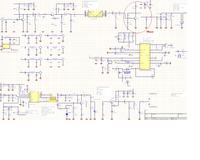darcyrandall2004
Full Member level 1
- Joined
- Feb 1, 2009
- Messages
- 97
- Helped
- 3
- Reputation
- 6
- Reaction score
- 0
- Trophy points
- 1,286
- Location
- Perth, WA, Australia
- Activity points
- 2,099
Hello,
Attached is a schematic that now only resembles the UHF receiver I have been designing. It simulates fine but when placed on a board it required alot of modifications to get working.
Anyway I can inject a signal at the Antennae port at -100dbm and view the signal on the spectrum analyzer after the saw filter at -90dbm. The oscillator works fine aswell. Presents about -15dbm to the mixer. The problem is the Mixer. I need to increase the signal strength at the antennae input to -50dbm before I will see a signal at 21.4MHz after the mixer with a signal strength of -90dbm.
Has anyone got an ideas as to what I can investigate to solve this problem?
I expect 10db conversion gain from my mixer. The equation for Minimum detectable signal states that MDS = -174dbm + NF(db) + 10LOG(bandwidth Hz) + SNR(db)
The Saw filter has a bandwidth of 8MHz. Assuming 10db NF my MDS = -94+ SNR(db). Surely I can expect better results than what I have been achieving in reality.
I have even experimented with other mixer designs including a 3V version. Any ideas?

Attached is a schematic that now only resembles the UHF receiver I have been designing. It simulates fine but when placed on a board it required alot of modifications to get working.
Anyway I can inject a signal at the Antennae port at -100dbm and view the signal on the spectrum analyzer after the saw filter at -90dbm. The oscillator works fine aswell. Presents about -15dbm to the mixer. The problem is the Mixer. I need to increase the signal strength at the antennae input to -50dbm before I will see a signal at 21.4MHz after the mixer with a signal strength of -90dbm.
Has anyone got an ideas as to what I can investigate to solve this problem?
I expect 10db conversion gain from my mixer. The equation for Minimum detectable signal states that MDS = -174dbm + NF(db) + 10LOG(bandwidth Hz) + SNR(db)
The Saw filter has a bandwidth of 8MHz. Assuming 10db NF my MDS = -94+ SNR(db). Surely I can expect better results than what I have been achieving in reality.
I have even experimented with other mixer designs including a 3V version. Any ideas?
